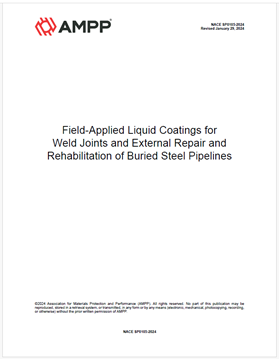Search
Products tagged with 'Standards Benefit For Members'
View as
Sort by
Display
per page
NACE Publication 80200/SSPC-TR 4-2000, Preparation of Protective Coating Specifications for Atmospheric Service
Product Number:
24209-SG
ISBN:
SSPC-TR4 80200
$109.00
NACE Publication 8X194-2006-SG, Materials and Fabrication Practices for New Pressure Vessels Used in Wet H2S Refinery Service
Product Number:
24179-SG
ISBN:
8X194 Materials
Publication Date:
2006
$109.00
NACE Publication 8X294-2013-SG, "Review of Published Literature on Wet H2S Cracking of Steels Through 1989"
Product Number:
24185-SG
Publication Date:
2013
$109.00
NACE SP0105-2024, Field-Applied Liquid Coatings for Weld Joints and External Repair and Rehabilitation of Buried Steel Pipelines
Product Number:
NACE SP0105-2024
Publication Date:
2024
$109.00
NACE SP0107-2021, Electrochemical Realkalization and Chloride Extraction for Reinforced Concrete
Product Number:
NACE SP0107-2021
Publication Date:
2021
$109.00
NACE SP0109-2023, Application of Tape Coatings for External Corrosion Protection of Buried Metal Pipelines
Product Number:
NACE SP0109-2023
Publication Date:
2023
$109.00
NACE SP0110-2024, Wet Gas Internal Corrosion Direct Assessment (WG-ICDA) Methodology for Pipelines
Product Number:
NACE SP0110-2024
Publication Date:
2024
$109.00
NACE SP0112-2023, Corrosion Management System for Atmospherically Exposed Reinforced Concrete Structures
Product Number:
NACE SP0112-2023
Publication Date:
2023
$109.00
NACE SP0113-2023, Pipeline Integrity Management: Methods Selection and Implementation
Product Number:
NACE SP0113-2023
Publication Date:
2023
$109.00
NACE SP0116-2022, Multiphase Flow Internal Corrosion Direct Assessment (MP-ICDA) Methodology for Pipelines
Product Number:
NACE SP0116-2022
Publication Date:
2022
$109.00
NACE SP0169-2024, Control of External Corrosion on Underground or Submerged Metallic Piping Systems
Product Number:
NACE SP0169-2024
Publication Date:
2024
$109.00
NACE SP0176-2022, Corrosion Control of Submerged Areas of Permanently Installed Steel Offshore Structures Associated with Petroleum Production
Product Number:
NACE SP0176-2022
Publication Date:
2022
$109.00












